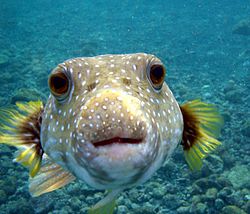Mital Pandya writes:
I consider myself a food enthusiast, and I spend a lot of time and effort reading reviews and traveling to seek out the best food out there. However, I don’t eat dolphin, but some people apparently do… Flipper anyone?
 In certain regions of Japan, many consider dolphin meat to be a delicacy, though unaware of the dangers associated with the meal. Two elected officials of a Japanese whaling town, Taiji, tested random samples of dolphin meat at supermarkets.
In certain regions of Japan, many consider dolphin meat to be a delicacy, though unaware of the dangers associated with the meal. Two elected officials of a Japanese whaling town, Taiji, tested random samples of dolphin meat at supermarkets.
“One dolphin sample had a mercury content 10 times above the health ministry’s advisory level of 0.4 parts per million, with a methylmercury readout 10.33 times over the ministry’s own advisory level of 0.3 ppm.”
The CDC also has an official report on mercury levels warning people of the health hazards of mercury, at http://www.atsdr.cdc.gov/tfacts46.html.
“The form of mercury that accumulates in the food chain is methylmercury. When small fish eat the methylmercury in food, it goes into their tissues. When larger fish eat smaller fish or other organisms that contain methylmercury, most of the methylmercury originally present in the small fish will then be stored in the bodies of the larger fish. As a result, the larger and older fish living in contaminated waters build up the highest amounts of methylmercury in their bodies.”
High levels of mercury can cause severe damage to the nervous system, as well as permanent damage to the brain and kidneys, and children are especially susceptible.
 Both the short term and long term damages caused by the consumption of dolphin meat are enough for me to say, “Dolphin it’s not for dinner."
Both the short term and long term damages caused by the consumption of dolphin meat are enough for me to say, “Dolphin it’s not for dinner."
Though this problem has been known for years now, it has recently been highlighted in the high-publicity documentary, The Cove, which won the audience award at Sundance Film Festival this year.
“Flipper was one of the most beloved television characters of all time. But ironically, the fascination with dolphins that he caused created a tragic epidemic that has threatened their existence and become a multibillion dollar industry. The largest supplier of dolphins in the world is located in the picturesque town of Taijii, Japan. But the town has a dark, horrifying secret that it doesn’t want the rest of the world to know. There are guards patrolling the cove, where the dolphin capturing takes place, who prevent any photography.”
.jpg) Mital Pandya is a current USDA research scientist in Orient Point, NY. In 2007 she received her Masters degree in Public Health from Ohio State University. She is passionate about food, loves to knit, and travel.
Mital Pandya is a current USDA research scientist in Orient Point, NY. In 2007 she received her Masters degree in Public Health from Ohio State University. She is passionate about food, loves to knit, and travel.

 However, Katie did confess she now misses my homemade-from-scratch buckwheat pancakes with berries.
However, Katie did confess she now misses my homemade-from-scratch buckwheat pancakes with berries. .jpg)


.png) As reported by the
As reported by the  crumbling across the nation,” and it’s leading consumers to “tak[e] a healthy interest in vegetables and other locally made produce.”
crumbling across the nation,” and it’s leading consumers to “tak[e] a healthy interest in vegetables and other locally made produce.”

 Michelle Mazur is a first-year veterinary student at Kansas State University, hailing from Wichita, Kansas. She is an avid dog lover, a crafty seamstress, and a bit of a workaholic. She recently spent
Michelle Mazur is a first-year veterinary student at Kansas State University, hailing from Wichita, Kansas. She is an avid dog lover, a crafty seamstress, and a bit of a workaholic. She recently spent  Michelle just returned from two weeks in Japan. I asked her to take some pictures of Japanese hand washing facilities and the like. In her own words,
Michelle just returned from two weeks in Japan. I asked her to take some pictures of Japanese hand washing facilities and the like. In her own words,.jpeg) He vomited while undergoing treatment, generating toxic chlorine gas.
He vomited while undergoing treatment, generating toxic chlorine gas. In a bizarrely inaccurate statement, Owen Roberts, a public relations-type for the University of Guelph in Canada, wrote in the
In a bizarrely inaccurate statement, Owen Roberts, a public relations-type for the University of Guelph in Canada, wrote in the